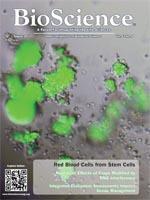Unlike tropical lagoons of pristine blue water, lagoons in the rural United States are home to a messy stew of ingredients that can harm the environment. One type of lagoon, found on factory farms, is a manure pit that spreads antibiotic resistant genes (ARGs). Another type of rural lagoon plays a beneficial role by treating sewage from small towns, a process that removes pharmaceuticals and personal care products (PPCPs). Researchers are studying the microbes involved in both of these types of lagoons as a way to help reduce environmental contamination.
According to the Union of Concerned Scientists, some 9900 confined animal feeding operations (CAFOs) in the United States generate 300 million tons of manure annually, more than twice what humans excrete. About half the antibiotics administered in the United States are used to treat farm animals, which, in turn, excrete ARGs, which end up in manure lagoons. “Antibiotic resistance is not just a huge medical problem but also a serious agricultural and environmental one. Genes that confer antibiotic resistance are pollutants,” says Pedro Alvarez, of Rice University, in Houston, Texas.
Alvarez tested two common antibioticresistant bacteria found on farms—Escherichia coli, excreted by farm animals, and Pseudomonas aeruginosa, a soil dweller that serves as a reservoir for ARGs. Both microbes have plasmids that confer resistance to tetracycline. Carrying these plasmids raises the microbe's metabolic and energy costs. Alvarez suspected that if they were starved, some bacteria would sacrifice their plasmids. “Bacteria prefer to use energy for more important functions,” he says.
When they were grown in the laboratory without tetracycline, oxygen, and nutrients (i.e., under starvation conditions), P. aeruginosa completely lost its tetracycline-resistant plasmid, whereas E. coli retained its plasmid. The results, reported in Environmental Science and Technology ( http://pubs.acs.org/doi/abs/10.1021/es3035329), suggest that some bacteria can be manipulated to drop ARGs like excess baggage.
To create starvation conditions in the field, Alvarez proposes strategically placing barriers of mulch in drainage channels to block oxygen and to exert selective pressure on bacteria to jettison ARGs. Mulch barriers could easily be built from CAFO compost piles.
Alvarez's hypothesis “makes sense,” and “mulch barriers are economically feasible,” says Amy Pruden, of Virginia Tech, in Blacksburg. Thousands of bacteria carry ARGs, though, and their ecology is complex. “Lots more work needs to be done to find the silver bullet conditions that remove most—if not all—ARGs,” she says.
Alvarez and Pruden worry that the environmental problems of ARGs are not being addressed, either by the US Food and Drug Administration, which is focused on the medical problems of ARGs, or by the US Department of Agriculture, which oversees farm animal health and productivity. More research could “fill in the cracks and find costeffective and synergistic approaches that help,” says Pruden.
In contrast to polluting lagoons at CAFOs, rural towns process about half of the nation's human sewage in some 8000 sewage treatment lagoons. Microorganisms, sunlight, and pumped-in air clean the wastewater. Aeration promotes microbial growth and speeds the biodegradation of contaminants. The effluent is discharged into nearby streams and rivers. “Lagoons are an economical way to handle sewage locally,” says Wei Zheng, at the University of Illinois at Urbana-Champaign.
Sewage contains PPCPs excreted by people or washed down the drain. The removal of PPCPs at municipal sewage treatment plants has been widely studied, but little is known about how effectively rural lagoons accomplish the task. Zheng collected water samples from two small-town aerated lagoons and tested them for 21 commonly used PPCPs.
The lagoons removed 88–100 percent of the PPCPs, including caffeine, Ibuprofen, triclosan, and hormones, according to a paper published in the 15 February 2013 issue of Science of the Total Environment ( http://dx.doi.org/10.1016/j.scitotenv.2012.12.035). The exception was the epilepsy drug carbamazepine, which is notoriously hard to remove, even at municipal sewage treatment plants. Samples collected in September had lower levels of PPCPs than those collected in November, probably because microbial degradation occurs faster in warmer water. Further studies are needed to identify and test the best microbes for degrading PPCPs.
Zheng's goal is to recycle rural lagoon effluent for irrigation, especially as droughts increase. “The effluent is rich in nutrients that could reduce the need for chemical fertilizers,” he says. The concern has been, though, that high levels of PPCPs could be absorbed by plants and passed into the food chain. “We showed [that] lagoon water is safe for irrigation,” Zheng says.
“In terms of PPCPs, lagoon water should be used for irrigation,” agrees Andrew Chang, of the University of California, Riverside. The low-nanogramper-liter levels of PPCPs detected by Zheng are not dangerous. “Bench-top studies show that much higher concentrations are needed to cause health concerns,” says Chang. In fact, rural lagoons may even be better at removing PPCPs than are municipal sewage treatment plants, which process water in just 6–10 hours. Instead, lagoons store water for months, Chang adds, “so there's ample opportunity to degrade PPCPs.”





